How do Microphones Work?
Microphones are a type of transducer - a device which converts energy from one form to another. Microphones convert acoustical energy (sound waves) into electrical energy (the audio signal).
Different types of microphone have different ways of converting energy but they all share one thing in common: The diaphragm. This is a thin piece of material (such as paper, plastic or aluminium) which vibrates when it is struck by sound waves. In a typical hand-held mic like the one below, the diaphragm is located in the head of the microphone.
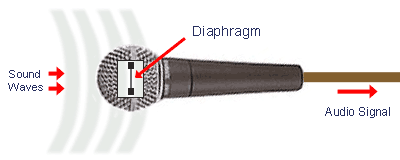
When the diaphragm vibrates, it causes other components in the microphone to vibrate. These vibrations are converted into an electrical current which becomes the audio signal.
Note: At the other end of the audio chain, the loudspeaker is also a transducer - it converts the electrical energy back into acoustical energy.
Types of Microphone
There are a number of different types of microphone in common use. The differences can be divided into two areas:
(1) The type of conversion technology they use
This refers to the technical method the mic uses to convert sound into electricity. The most common technologies are dynamic, condenser, ribbon and crystal. Each has advantages and disadvantages, and each is generally more suited to certain types of application. The following pages will provide details.
(2) The type of application they are designed for
Some mics are designed for general use and can be used effectively in many different situations. Others are very specialised and are only really useful for their intended purpose. Characteristics to look for include directional properties, frequency response and impedance (more on these later).
Mic Level & Line Level
The electrical current generated by a microphone is very small. Referred to as mic level, this signal is typically measured in millivolts. Before it can be used for anything serious the signal needs to be amplified, usually to line level (typically 0.5 -2V). Being a stronger and more robust signal, line level is the standard signal strength used by audio processing equipment and common domestic equipment such as CD players, tape machines, VCRs, etc.
This amplification is achieved in one or more of the following ways:
- Some microphones have tiny built-in amplifiers which boost the signal to a high mic level or line level.
- The mic can be fed through a small boosting amplifier, often called a line amp.
- Sound mixers have small amplifiers in each channel. Attenuators can accommodate mics of varying levels and adjust them all to an even line level.
- The audio signal is fed to a power amplifier - a specialised amp which boosts the signal enough to be fed to loudspeakers.
Dynamic Microphones
Dynamic microphones are versatile and ideal for general-purpose use. They use a simple design with few moving parts. They are relatively sturdy and resilient to rough handling. They are also better suited to handling high volume levels, such as from certain musical instruments or amplifiers. They have no internal amplifier and do not require batteries or external power.
How Dynamic Microphones Work
As you may recall from your school science, when a magnet is moved near a coil of wire an electrical current is generated in the wire. Using this electromagnet principle, the dynamic microphone uses a wire coil and magnet to create the audio signal.
The diaphragm is attached to the coil. When the diaphragm vibrates in response to incoming sound waves, the coil moves backwards and forwards past the magnet. This creates a current in the coil which is channeled from the microphone along wires. A common configuration is shown below. 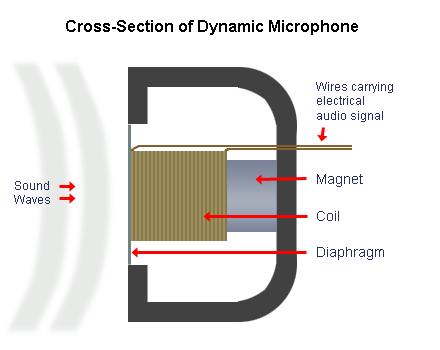
Earlier we mentioned that loudspeakers perform the opposite function of microphones by converting electrical energy into sound waves. This is demonstrated perfectly in the dynamic microphone which is basically a loudspeaker in reverse. When you see a cross-section of a speaker you'll see the similarity with the diagram above. If fact, some intercom systems use the speaker as a microphone. You can also demonstrate this effect by plugging a microphone into the headphone output of your stereo, although we don't recommend it!
Technical Notes:
Dynamics do not usually have the same flat frequency response as condensers. Instead they tend to have tailored frequency responses for particular applications.
Neodymium magnets are more powerful than conventional magnets, meaning that neodymium microphones can be made smaller, with more linear frequency response and higher output level.
Condenser Microphones
Condenser means capacitor, an electronic component which stores energy in the form of an electrostatic field. The term condenser is actually obsolete but has stuck as the name for this type of microphone, which uses a capacitor to convert acoustical energy into electrical energy.
Condenser microphones require power from a battery or external source. The resulting audio signal is stronger signal than that from a dynamic. Condensers also tend to be more sensitive and responsive than dynamics, making them well-suited to capturing subtle nuances in a sound. They are not ideal for high-volume work, as their sensitivity makes them prone to distort.
How Condenser Microphones Work
A capacitor has two plates with a voltage between them. In the condenser mic, one of these plates is made of very light material and acts as the diaphragm. The diaphragm vibrates when struck by sound waves, changing the distance between the two plates and therefore changing the capacitance. Specifically, when the plates are closer together, capacitance increases and a charge current occurs. When the plates are further apart, capacitance decreases and a discharge current occurs.
A voltage is required across the capacitor for this to work. This voltage is supplied either by a battery in the mic or by external phantom power.
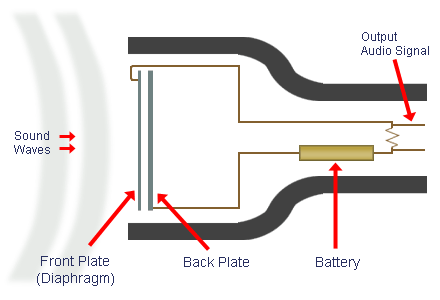
Electret Condenser Microphone
The electret condenser mic uses a special type of capacitor which has a permanent voltage built in during manufacture. This is somewhat like a permanent magnet, in that it doesn't require any external power for operation. However good electret condenders mics usually include a pre-amplifier which does still require power.
Other than this difference, you can think of an electret condenser microphone as being the same as a normal condenser.
Technical Notes:
- Condenser microphones have a flatter frequency response than dynamics.
- A condenser mic works in much the same way as an electrostatic tweeter (although obviously in reverse).
Directional Properties
Every microphone has a property known as directionality. This describes the microphone's sensitivity to sound from various directions. Some microphones pick up sound equally from all directions, others pick up sound only from one direction or a particular combination of directions. The types of directionality are divided into three main categories:
- Omnidirectional
Picks up sound evenly from all directions (omni means "all" or "every").
- Unidirectional
Picks up sound predominantly from one direction. This includes cardioid and hypercardioid microphones (see below).
- Bidirectional
Picks up sound from two opposite directions.
To help understand a the directional properties of a particular microphone, user manuals and promotional material often include a graphical representation of the microphone's directionality. This graph is called a polar pattern. Some typical examples are shown below.
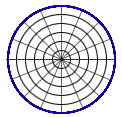 Omnidirectional Omnidirectional
Captures sound equally from all directions.
Uses: Capturing ambient noise; Situations where sound is coming from many directions; Situations where the mic position must remain fixed while the sound source is moving.
Notes:
- Although omnidirectional mics are very useful in the right situation, picking up sound from every direction is not usually what you need. Omni sound is very general and unfocused - if you are trying to capture sound from a particular subject or area it is likely to be overwhelmed by other noise.
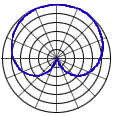 Cardioid Cardioid
Cardioid means "heart-shaped", which is the type of pick-up pattern these mics use. Sound is picked up mostly from the front, but to a lesser extent the sides as well.
Uses: Emphasising sound from the direction the mic is pointed whilst leaving some latitude for mic movement and ambient noise.
Notes:
- The cardioid is a very versatile microphone, ideal for general use. Handheld mics are usually cardioid.
- There are many variations of the cardioid pattern (such as the hypercardioid below).
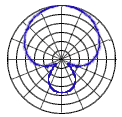 Hypercardioid Hypercardioid
This is exaggerated version of the cardioid pattern. It is very directional and eliminates most sound from the sides and rear. Due to the long thin design of hypercardioids, they are often referred to as shotgun microphones.
Uses: Isolating the sound from a subject or direction when there is a lot of ambient noise; Picking up sound from a subject at a distance.
Notes:
- By removing all the ambient noise, unidirectional sound can sometimes be a little unnatural. It may help to add a discreet audio bed from another mic (i.e. constant background noise at a low level).
- You need to be careful to keep the sound consistent. If the mic doesn't stay pointed at the subject you will lose the audio.
- Shotguns can have an area of increased sensitivity directly to the rear.
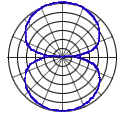 Bidirectional Bidirectional
Uses a figure-of-eight pattern and picks up sound equally from two opposite directions.
Uses: As you can imagine, there aren't a lot of situations which require this polar pattern. One possibility would be an interview with two people facing each other (with the mic between them).
Variable Directionality
Some microphones allow you to vary the directional characteristics by selecting omni, cardioid or shotgun patterns.
This feature is sometimes found on video camera microphones, with the idea that you can adjust the directionality to suit the angle of zoom, e.g. have a shotgun mic for long zooms. Some models can even automatically follow the lens zoom angle so the directionality changes from cardioid to shotgun as you zoom in.
Although this seems like a good idea (and can sometimes be handy), variable zoom microphones don't perform particularly well and they often make a noise while zooming. Using different mics will usually produce better results.
Microphone Impedance
When dealing with microphones, one consideration which is often misunderstood or overlooked is the microphone's impedance rating. Perhaps this is because impedance isn't a "critical" factor; that is, microphones will still continue to operate whether or not the best impedance rating is used. However, in order to ensure the best quality and most reliable audio, attention should be paid to getting this factor right.
If you want the short answer, here it is: Low impedance is better than high impedance.
If you're interested in understanding more, read on....
What is Impedance?
Impedance is an electronics term which measures the amount of opposition a device has to an AC current (such as an audio signal). Technically speaking, it is the combined effect of capacitance, inductance, and resistance on a signal. The letter Z is often used as shorthand for the word impedance, e.g. Hi-Z or Low-Z.
Impedance is measured in ohms, shown with the Greek Omega symbol Ω. A microphone with the specification 600Ω has an impedance of 600 ohms.
What is Microphone Impedance?
All microphones have a specification referring to their impedance. This spec may be written on the mic itself (perhaps alongside the directional pattern), or you may need to consult the manual or manufacturer's website.
You will often find that mics with a hard-wired cable and 1/4" jack are high impedance, and mics with separate balanced audio cable and XLR connector are low impedance.
There are three general classifications for microphone impedance. Different manufacturers use slightly different guidelines but the classifications are roughly:
- Low Impedance (less than 600Ω)
- Medium Impedance (600Ω - 10,000Ω)
- High Impedance (greater than 10,000Ω)
Note that some microphones have the ability to select from different impedance ratings.
Which Impedance to Choose?
High impedance microphones are usually quite cheap. Their main disadvantage is that they do not perform well over long distance cables - after about 5 or 10 metres they begin producing poor quality audio (in particular a loss of high frequencies). In any case these mics are not a good choice for serious work. In fact, although not completely reliable, one of the clues to a microphone's overall quality is the impedance rating.
Low impedance microphones are usually the preferred choice.
Matching Impedance with Other Equipment
Microphones aren't the only things with impedance. Other equipment, such as the input of a sound mixer, also has an ohms rating. Again, you may need to consult the appropriate manual or website to find these values. Be aware that what one system calls "low impedance" may not be the same as your low impedance microphone - you really need to see the ohms value to know exactly what you're dealing with.
A low impedance microphone should generally be connected to an input with the same or higher impedance. If a microphone is connected to an input with lower impedance, there will be a loss of signal strength.
In some cases you can use a line matching transformer, which will convert a signal to a different impedance for matching to other components.
Microphone Frequency Response
Frequency response refers to the way a microphone responds to different frequencies. It is a characteristic of all microphones that some frequencies are exaggerated and others are attenuated (reduced). For example, a frequency response which favours high frequencies means that the resulting audio output will sound more trebly than the original sound.
Frequency Response Charts
A microphone's frequency response pattern is shown using a chart like the one below and referred to as a frequency response curve. The x axis shows frequency in Hertz, the y axis shows response in decibels. A higher value means that frequency will be exaggerated, a lower value means the frequency is attenuated. In this example, frequencies around 5 - kHz are boosted while frequencies above 10kHz and below 100Hz are attenuated. This is a typical response curve for a vocal microphone. 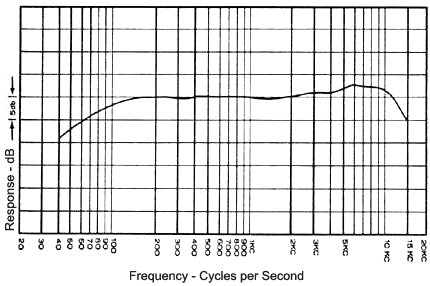
Which Response Curve is Best?
An ideal "flat" frequency response means that the microphone is equally sensitive to all frequencies. In this case, no frequencies would be exaggerated or reduced (the chart above would show a flat line), resulting in a more accurate representation of the original sound. We therefore say that a flat frequency response produces the purest audio.
In the real world a perfectly flat response is not possible and even the best "flat response" microphones have some deviation.
More importantly, it should be noted that a flat frequency response is not always the most desirable option. In many cases a tailored frequency response is more useful. For example, a response pattern designed to emphasise the frequencies in a human voice would be well suited to picking up speech in an environment with lots of low-frequency background noise.
The main thing is to avoid response patterns which emphasise the wrong frequencies. For example, a vocal mic is a poor choice for picking up the low frequencies of a bass drum.
Frequency Response Ranges
You will often see frequency response quoted as a range between two figures. This is a simple (or perhaps "simplistic") way to see which frequencies a microphone is capable of capturing effectively. For example, a microphone which is said to have a frequency response of 20 Hz to 20 kHz can reproduce all frequencies within this range. Frequencies outside this range will be reproduced to a much lesser extent or not at all.
This specification makes no mention of the response curve, or how successfully the various frequencies will be reproduced. Like many specifications, it should be taken as a guide only.
Condenser vs Dynamic
Condenser microphones generally have flatter frequency responses than dynamic. All other things being equal, this would usually mean that a condenser is more desirable if accurate sound is a prime consideration.
|

